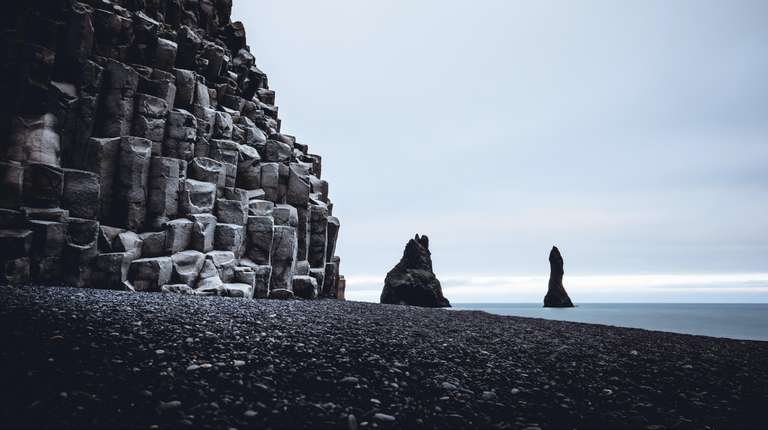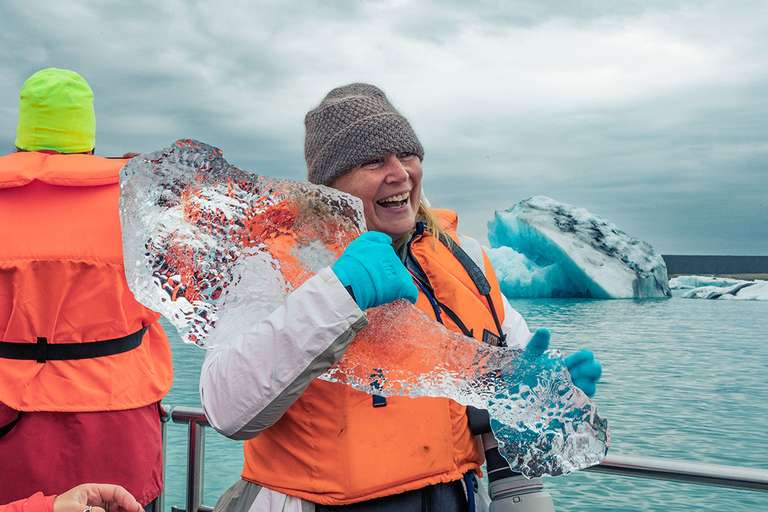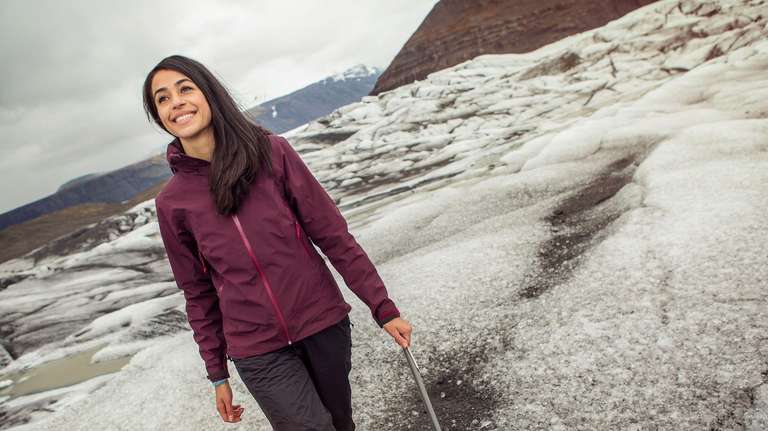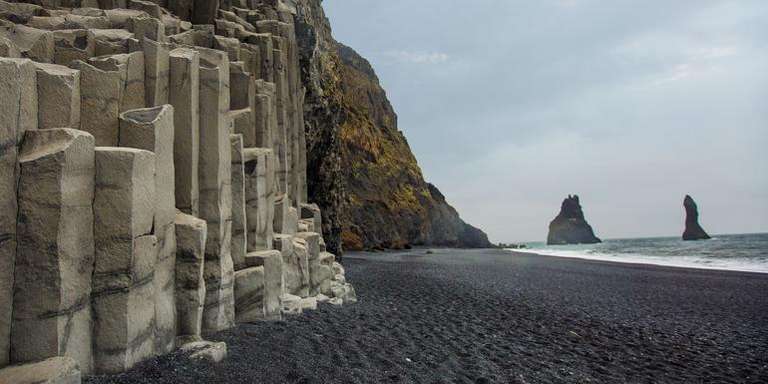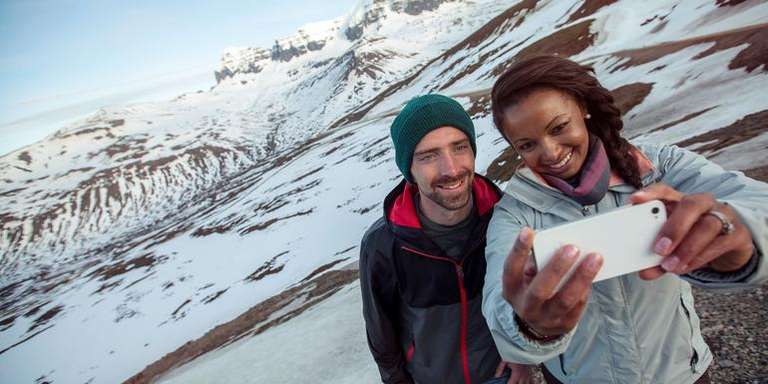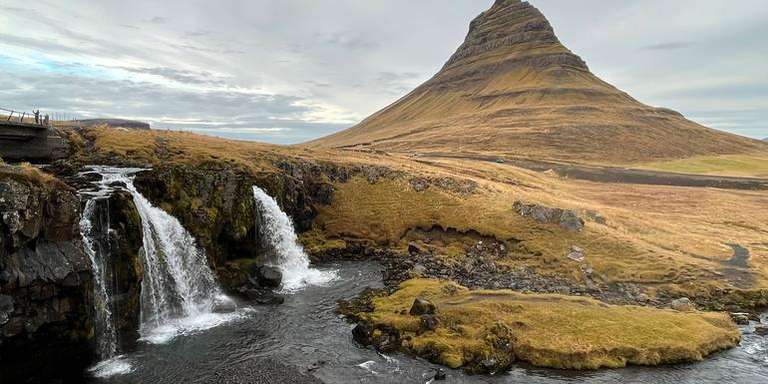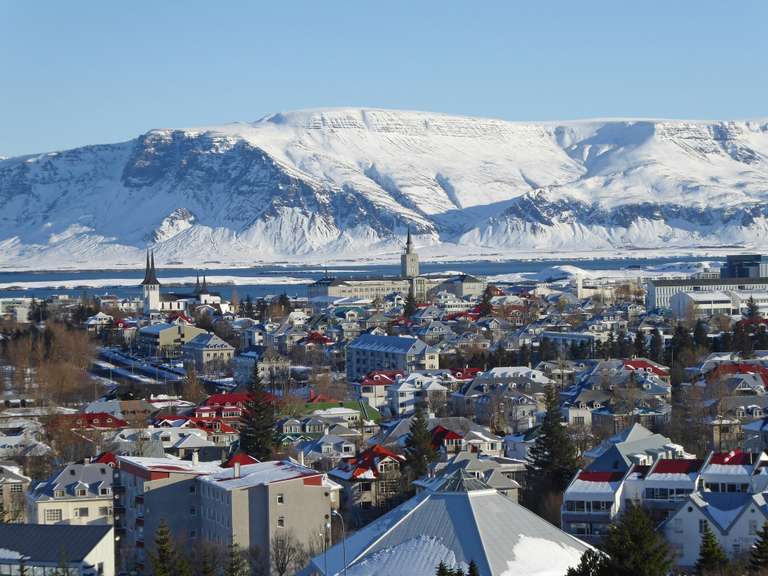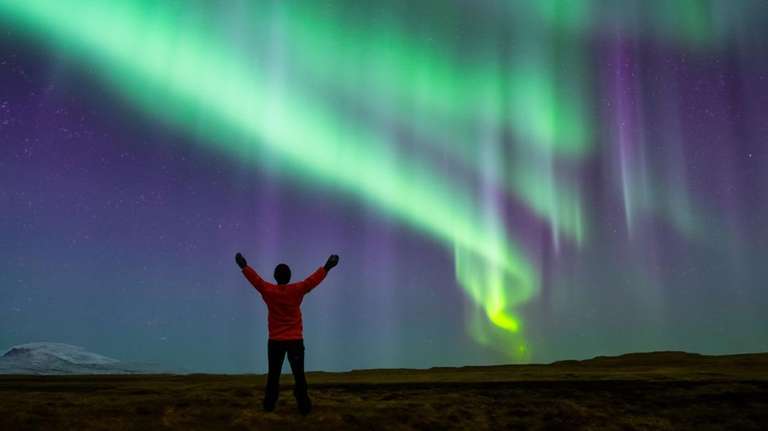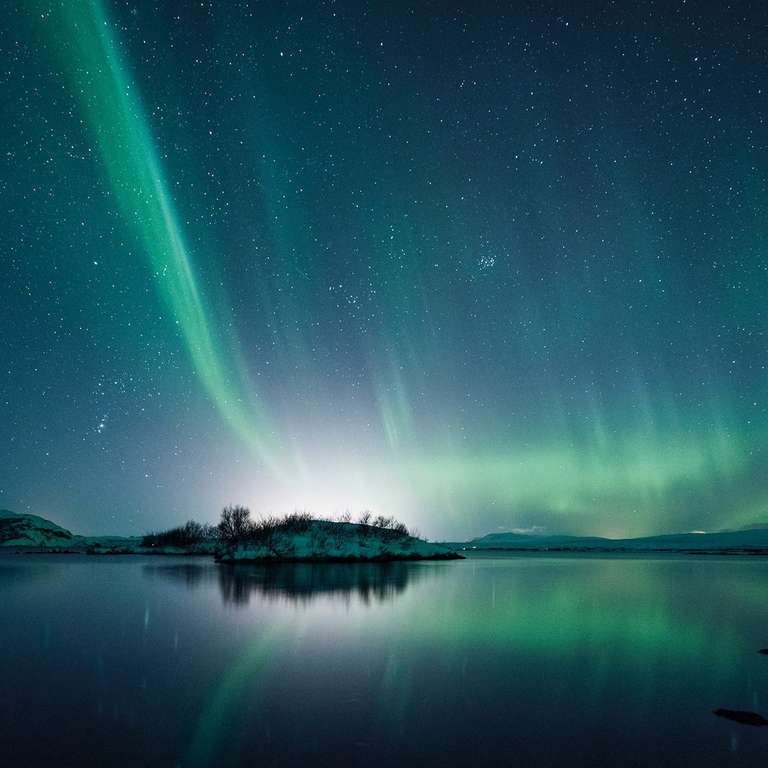Iceland in Winter: Weather, Places to Visit, and More!

- Fleur Elliott
- From
- Fleur Elliott
- From
- Sally Campbell
- From
- Carly J
- From
Weather and Temperature in Iceland During Winter
Winter in Iceland typically runs from mid-November until March. However, owing to the region's proximity to the Arctic Circle and its volatile weather patterns, winter conditions can commence as early as mid-October.
Iceland’s winters are cold with the daytime temperature averaging 4°C (40°F) and dropping to -1°C (31°F) at night. North Iceland is colder still. Places such as Akureyri sees temperature hovering around 0°C (32°F). South Iceland is slightly warmer, but only by a couple of degrees. For instance, the village of Vik averages 2°C (36°F) during the winter months.
Iceland also sees shorter days and longer nights during winter. December, January, and February are the darkest—and also the coldest—months. Daylight hours are at their lowest during these three months, and soft twilight turns the landscape golden on clear days. Winter also brings a lot of snowfall in Iceland, with the capital Reykjavik witnessing 6.7 to 9 inches of snow each month. March is the month of the heaviest snowfall, with up to 9.1 inches of snow.
| November | December | January | February | March | |
| Avg high | 5°C (41°F) | 4°C (39°F) | 3°C (37°F) | 2°C (36°F) | 2°C (36°F) |
| Avg low | 0°C (32°F) | -1°C (40°F) | -3°C (27°F) | -2°C (28°F) | -2°C (28°F) |
| Rainfall (mm) | 29 | 35 | 47 | 33 | 40 |
| Daylight hours | 6h 31 min | 4h 24 min | 5h 36 min | 8h 36 min | 11h 49 min |
For a more detailed seasonal overview, check out our guide on the best time to visit Iceland.
Other Related Articles:
Iceland in December
Iceland in January
Iceland in February
Iceland in March
Why Visit Iceland in Winter?
There are plenty of reasons to take a trip to Iceland in the winter. Here are some of them:
- Northern Lights: Iceland's winter offers one of the best opportunities to witness the Northern Lights due to long nights, less light pollution, and clear skies. November, December, and January are the darkest months of the year with the longest nights, creating the perfect conditions to experience the Northern Lights.
- Ice cave formations: Winter is the only time you can explore the mesmerizing ice caves, formed within glaciers by the interplay of ice and water. Their stunning blue hues and intricate formations create a unique underground world that's accessible during this season.
- Geothermal baths: Enjoy the contrast of soaking in geothermal hot springs, like the Secret Lagoon or Mývatn Nature Baths, while the air is chilly and snowflakes fall gently around you.
- Winter sports: Winter in Iceland offers the opportunity to enjoy ice and snow-centric activities like glacier hiking, snowmobiling, and exploring ice caves.
If you are considering a trip to Iceland, we recommend looking at our Iceland guide for a clear overview of the country.
Top Destinations to Visit in Iceland during Winter
Iceland offers an array of exciting things to do and places to see during the winter months. Here are some of the top destinations that you should not miss:
1. Vatnajokull National Park
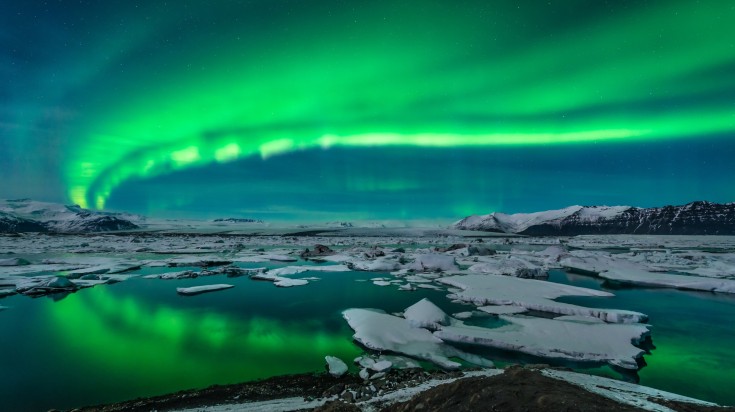
Vatnajokull Glacier, Europe's largest glacier, becomes an even more compelling destination during winter. Encompassing eight percent of Iceland's landmass in a pristine blanket of glacial ice, it transforms into a breathtaking spectacle against the winter backdrop. The park boasts over 30 outlet glaciers and an array of captivating natural ice caves that are fully accessible during winter. And as the day turns into the prolonged night of winter, Vatnajokull's remote expanse offers a front-row seat to the ethereal Northern Lights.
Major attractions: Vatnajokull Glacier, Ice Cave Tours, Jokulsarlon Glacier Lagoon (southern part of the park)
Pros:
- The stunning frozen landscapes during winter are perfect for activities like glacier hikes and ice cave exploration.
- Jokulsarlon Glacier Lagoon, which lies within the park, is one of the best places in Iceland for Northern Lights sightings.
Cons:
- The weather can be quite extreme during the winter season.
2. Golden Circle

While it is true that summer is the most popular time to explore Iceland's tourist route, Golden Circle, there is a distinct charm of taking the trip during the winter months. With fewer tourists, you can savor its wonders at a leisurely pace, relishing the serenity. Major attractions such as Thingvellir National Park and Gullfoss Waterfall, meanwhile, provide prime conditions for Northern Lights sightings. The Geysir Hot Springs Area has its own allure with its snow-covered landscape. Strokkur Geyser offers the most captivating eruptions.
Major attractions: Thingvellir National Park, Geysir geothermal area, Gullfoss waterfall, Kerid volcanic crater.
Pros:
- The Golden Circle remains accessible throughout winter, thanks to the well-maintained Ring Road, a privilege not shared by many of the popular destinations in Iceland that remain closed throughout the winter months.
- You can witness the partially-frozen Gullfoss Waterfall only during the winter months.
Cons:
- The limited daylight hours during winter make it difficult to cover the entirety of the Golden Circle in one day.
3. Mývatn

Mývatn is a stunning shallow lake near Krafla volcano. In winter, it is a captivating wonderland where warm geothermal baths to its east provide an exquisite contrast to its icy waters and the nearby snow-draped volcanic landscapes. While tourists flock to the south due to restrictions, Mývatn remains open, offering a secluded retreat adorned with the ethereal beauty of a frozen lake and snow-blanketed terrain. Taking a dip in the mineral-rich waters of Mývatn Nature Baths, also referred to as the "Blue Lagoon of the North," is the perfect way to relax and warm your travel-weary body during your winter Iceland trip. In Mývatn, you can also experience the thrill of ice riding on horses as the lake is frozen.
Major attractions: Mývatn Nature Baths, Hverfjall volcano, Dimmuborgir lava formations.
Pros:
- Taking a dip in the warm, mineral-rich waters of Mývatn Nature Baths can be a rejuvenating experience.
- Winter is the only time you can walk on the solid ice surface of Lake Mývatn.
Cons:
- Driving to Lake Mývatn on your own can be dangerous, as most of the roads in Iceland are not serviced at all during the winter season.
3 Things to Do in Iceland During Winter
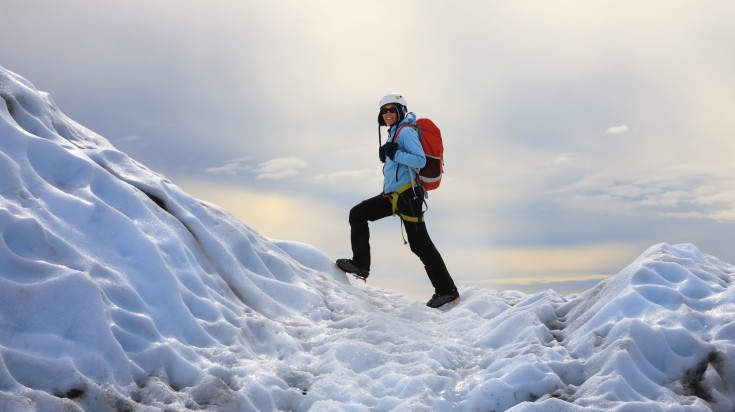

Iceland in winter offers an array of exhilarating activities like glacier hiking, ice caving, and chasing the Northern Lights. This is also the perfect time to see the country's stunning landscapes.
- Enjoy glacier hiking: When it comes to experiencing the sheer wonder of glacier hiking, winter in Iceland offers the ultimate condition. Sólheimajökull and Vatnajökull are the two prime destinations for glacier hiking. Sólheimajökull, a mere two-hour drive from Reykjavik in the south, makes for an accessible day trip from the capital, often paired with a visit to the magnificent Skógafoss waterfall. Vatnajökull, Europe's largest glacier, within Vatnajökull National Park, is crowd-free during winter, making it an excellent choice for a glacier hiking expedition.
- Go ice caving: One of the coolest Iceland winter activities is ice caving in a glacier. Natural glacier ice caves are a sight to behold and they are accessible only during the winter months, as the ice stays frozen solid. The best places to go for an ice-caving adventure are the Vatnajökull and Kötlujökull glaciers. Formed naturally into ethereal shapes and twisted tunnels, guided ice cave tours can be both fun and exciting.
- Partake in Iceland's unique Christmas festivities: Iceland celebrates its traditional Christmas festival in December, which provides a distinctive and extended Christmas experience. According to folklore, thirteen playful Yule (Christmas) lads deliver gifts or potatoes to children every night of 13 days leading up to Christmas, while the formidable Yule cat roams, promoting the tradition of gifting new clothes. So the days leading up to Christmas are filled with gifting and receiving new clothes. This exceptional custom underscores the importance of generosity.
Travel Tips for Visiting Iceland in Winter
Here are some things to keep in mind while traveling to Iceland in winter:
- Because there are limited daylight hours during winter in Iceland, we recommend that you start your days early to make the most of your trip.
- Winter weather can change rapidly, affecting road conditions. Regularly check weather forecasts and road condition websites like safetravel.is to ensure travel safety.
- Popular winter activities like ice cave tours and Northern Lights chasing can fill up quickly. Reserve your spots in advance to guarantee your spot.
- Plan outdoor activities during daylight, and have a backup plan for indoor activities when darkness falls.
- If you are taking a self-driving trip in Iceland during winter, be sure to rent 4X4 super jeeps that can drive through slippery roads and snowy conditions.
Traveling to Iceland in winter is an adventure like no other. While the weather may be cold and dark, you will find a wealth of things to see and do, from ice-caving and glacier hiking to exploring black sand beaches and whale-watching.
If you're looking to travel to Iceland soon, let our travel experts curate the perfect trip for you with our customizable trips to Iceland.
FAQs
1. Is it totally dark in Iceland during winter?
Due to the country's high latitude, sunlight is limited in Iceland during winter. Daylight hours range from four hours during December to eight hours during February. However, the further north you travel, the shorter the daylight hours.
2. How long does it take to explore Iceland during the winter season?
You will need at least a week in Iceland and at most ten days to explore the country in winter. This timeframe allows you to traverse the complete length of the Ring Road, which remains open year-round, doesn't necessitate the use of super jeeps, and covers almost all the popular landmarks along the way.


